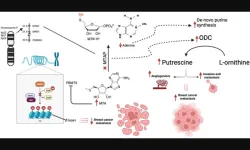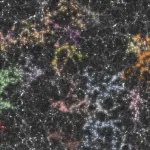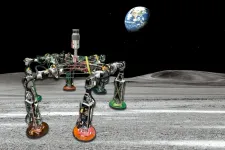(Press-News.org) Since the development of functional magnetic resonance imaging in the 1990s, the reliance on neuroimaging has skyrocketed as researchers investigate how fMRI data from the brain at rest, and anatomical brain structure itself, can be used to predict individual traits, such as depression, cognitive decline, and brain disorders.
Brain imaging has the potential to reveal the neural underpinnings of many traits, from disorders like depression and chronic widespread pain to why one person has a better memory than another, and why some people’s memories are resilient as they age. But how reliable brain imaging is for detecting traits has been a subject of wide debate.
Prior research on brain-wide associated studies (termed ‘BWAS’) has shown that links between brain function and structure and traits are so weak that thousands of participants are needed to detect replicable effects. Research of this scale requires millions of dollars in investment in each study, limiting which traits and brain disorders can be studied.
However, according to a new commentary published in Nature, stronger links between brain measures and traits can be obtained when state-of-the-art pattern recognition (or ‘machine learning’) algorithms are utilized, which can garner high-powered results from moderate sample sizes.
In their article, researchers from Dartmouth and University Medicine Essen provide a response to an earlier analysis of brain-wide association studies led by Scott Marek at Washington University School of Medicine in St. Louis, Brenden Tervo-Clemmens at Massachusetts General Hospital/Harvard Medical School, and colleagues. The earlier study found very weak associations across a range of traits in several large brain imaging studies, concluding that thousands of participants would be needed to detect these associations.
The new article explains that the very weak effects found in the earlier paper do not apply to all brain images and all traits, but rather are limited to specific cases. It outlines how fMRI data from hundreds of participants, as opposed to thousands, can be better leveraged to yield important diagnostic information about individuals.
One key to stronger associations between brain images and traits such as memory and intelligence is the use of state-of-the-art pattern recognition algorithms. “Given that there’s virtually no mental function performed entirely by one area of the brain, we recommend using pattern recognition to develop models of how multiple brain areas contribute to predicting traits, rather than testing brain areas individually,” says senior author Tor Wager, the Diana L. Taylor Distinguished Professor of Psychological and Brain Sciences and director of the Brain Imaging Center at Dartmouth.
“If models of multiple brain areas working together rather than in isolation are applied, this provides for a much more powerful approach in neuroimaging studies, yielding predictive effects that are four times larger than when testing brain areas in isolation,” says lead author Tamas Spisak, head of the Predictive Neuroimaging Lab at the Institute of Diagnostic and Interventional Radiology and Neuroradiology at University Medicine Essen.
However, not all pattern recognition algorithms are equal and finding the algorithms that work best for specific types of brain imaging data is an active area of research. The earlier paper by Marek, Tervo-Clemmens et al. also tested whether pattern recognition can be used to predict traits from brain images, but Spisak and colleagues found that the algorithm they used is suboptimal.
When the researchers applied a more powerful algorithm, the effects got even larger and reliable associations could be detected in much smaller samples. “When you do the power calculations on how many participants are needed to detect replicable effects, the number drops to below 500 people,” Spisak says.
“This opens the field to studies of many traits and clinical conditions for which obtaining thousands of patients is not possible, including rare brain disorders,” says co-author Ulrike Bingel at University Medicine Essen, who is the head of the University Centre for Pain Medicine. “Identifying markers, including those involving the central nervous system, are urgently needed, as they are critical to improve diagnostics and individually tailored treatment approaches. We need to move towards a personalized medicine approach grounded in neuroscience. The potential for multivariate BWAS to move us towards this goal should not be underestimated.”
The team explains that the weak associations found in the earlier analysis, particularly through brain images, were collected while people were simply resting in the scanner, rather than performing tasks. But fMRI can also capture brain activity linked to specific moment-by-moment thoughts and experiences.
Wager believes that linking brain patterns to these experiences may be a key to understanding and predicting differences among individuals. “One of the challenges associated with using brain imaging to predict traits is that many traits aren’t stable or reliable. If we use brain imaging to focus on studying mental states and experiences, such as pain, empathy, and drug craving, the effects can be much larger and more reliable,” says Wager. “The key is finding the right task to capture the state.”
“For example, showing images of drugs to people with substance use disorders can elicit drug cravings, according to an earlier study revealing a neuromarker for cravings,” says Wager.
“Identifying which approaches to understanding the brain and mind are most likely to succeed is important, as this affects how stakeholders view and ultimately fund translational research in neuroimaging,” says Bingel. “Finding the limitations and working together to overcome them is key to developing new ways of diagnosing and caring for patients with brain and mental health disorders.”
Wager (Tor.D.Wager@dartmouth.edu) and Spisak (tamas.spisak@uk-essen.de) are available for comment.
###
END
How neuroimaging can be better utilized to yield diagnostic information about individuals
2023-03-14
ELSE PRESS RELEASES FROM THIS DATE:
NASA’s Webb Telescope captures rarely seen prelude to supernova
2023-03-14
The rare sight of a Wolf-Rayet star – among the most luminous, most massive, and most briefly detectable stars known – was one of the first observations made by NASA’s James Webb Space Telescope in June 2022. Webb shows the star, WR 124, in unprecedented detail with its powerful infrared instruments. The star is 15,000 light-years away in the constellation Sagittarius.
Massive stars race through their lifecycles, and only some of them go through a brief Wolf-Rayet phase before going supernova, making Webb’s detailed observations of this rare phase valuable to astronomers. Wolf-Rayet stars are in the process of casting off their outer layers, ...
Potential treatment target for drug-resistant epilepsy identified
2023-03-14
Researchers at Tufts University School of Medicine and colleagues have identified a small molecule that may help treat people with epilepsy whose condition has become resistant to the benzodiazepine drugs usually used in managing seizures. The research, conducted in laboratory cells and rodents, was published online March 7 in Cell Reports Medicine.
Uncontrolled epilepsy can lead to frequent and prolonged seizures lasting five minutes or more that can cause brain cell damage and even death. The condition affects an estimated 3.4 million people in the U.S. and millions more worldwide.
Epilepsy occurs ...
New model provides improved air-quality predictions in fire-prone areas
2023-03-14
UNIVERSITY PARK, Pa. — Globally, wildfires are becoming more frequent and destructive, generating a significant amount of smoke that can be transported thousands of miles, driving the need for more accurate air pollution forecasts. A team of Penn State researchers developed a deep learning model that provides improved predictions of air quality in wildfire-prone areas and can differentiate between wildfires and non-wildfires.
“As climate change continues to cause ecological changes and challenges, it is likely that wildfire ...
New study finds early warning signs prior to 2002 Antarctic ice shelf collapse
2023-03-14
UNIVERSITY PARK, Pa. — In 2002, an area of ice about the size of Rhode Island dramatically broke away from Antarctica as the Larsen B ice shelf collapsed. A new study of the conditions that led to the collapse may reveal warning signs to watch for future Antarctic ice shelf retreat, according to a Penn State-led team of scientists.
“The collapse of the Larsen B ice shelf is generally thought of as an independent event,” said Shujie Wang, assistant professor of geography at Penn State. “Our ...
Oncotarget | MTAP loss in metastatic breast cancer patients: Genomic landscape
2023-03-14
“In breast cancer, MTAP downregulation activates ornithine decarboxylase (ODC) which in turn leads to formation of putrescine which promotes tumor migration, invasion and angiogenesis [15].”
BUFFALO, NY- March 14, 2023 – A new research paper was published in Oncotarget's Volume 14 on March 11, 2023, entitled, “Genomic landscape of metastatic breast cancer (MBC) patients with methylthioadenosine phosphorylase (MTAP) loss.”
Homozygous deletion of methylthioadenosine phosphorylase (MTAP) upregulates de novo synthesis ...
Tim Michalski selected as Jefferson Lab’s engineering manager
2023-03-14
NEWPORT NEWS, VA – The U.S. Department of Energy’s (DOE) Thomas Jefferson National Accelerator Facility has selected Tim Michalski to lead its Engineering Division as the Engineering Division Manager. In this role, Michalski oversees all aspects of the management and operation of the Engineering Division. The division includes more than 200 staff members and supports the Continuous Electron Beam Accelerator Facility and the lab’s growing project portfolio.
“I am proud to name Tim as our newest Engineering Division Manager,” said Jefferson Lab Director Stuart Henderson. “Tim has ...
Princeton Chem, IAS uncover spatial patterns in distribution of galaxies
2023-03-14
In late 2021, Salvatore Torquato, on sabbatical from Princeton’s Department of Chemistry, reached across the aisle as it were and invited a young astrophysicist at the Institute for Advanced Study to apply the tools of statistical mechanics to his own work on the distribution of galaxies.
The astrophysicist, Oliver Philcox, now a postdoc at the Simons Foundation, was intrigued. A year-long collaboration ensued.
The questions at the heart of their unusual partnership were straightforward: can the statistical descriptors Torquato has worked with throughout his career find application in unlikely places like cosmology, and can they accurately characterize the complexity in the distribution ...
Researchers look to AI for decision-making in extreme situations
2023-03-14
Imagine you are a doctor managing the emergency room of a large hospital. You suddenly get a call reporting a mass shooting at a nearby concert. In 20 minutes, you will be responsible for triaging more than 200 patients with a range of injuries. You do not have enough staff or resources and the hospital policies are not designed for a situation this dire.
“When people respond to emergencies, many decisions they face are quite predictable. They’re trained on them, and there’s policy,” said UMass Lowell’s Neil Shortland, associate professor in the School of Criminology and Justice Studies. “But every now and then, they get stuck with a really ...
Mix-and-match kit could enable astronauts to build a menagerie of lunar exploration bots
2023-03-14
When astronauts begin to build a permanent base on the moon, as NASA plans to do in the coming years, they’ll need help. Robots could potentially do the heavy lifting by laying cables, deploying solar panels, erecting communications towers, and building habitats. But if each robot is designed for a specific action or task, a moon base could become overrun by a zoo of machines, each with its own unique parts and protocols.
To avoid a bottleneck of bots, a team of MIT engineers is designing a kit of universal ...
Common dry cleaning chemical linked to Parkinson’s
2023-03-14
A common and widely used chemical may be fueling the rise of the world’s fastest growing brain condition – Parkinson’s disease. For the past 100 years, trichloroethylene (TCE) has been used to decaffeinate coffee, degrease metal, and dry clean clothes. It contaminates the Marine Corps base Camp Lejeune, 15 toxic Superfund sites in Silicon Valley, and up to one-third of groundwater in the U.S. TCE causes cancer, is linked to miscarriages and congenital heart disease, and is associated ...





